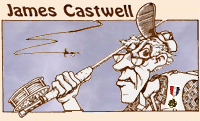|
Where else can a person wave a wand and step
from today's reality back in time and join with
the ranks of individuals who collectively formed
over eons what could quite conceivably be
considered a religion. At the least a
fraternity of fellows captivated by the nuances
of a sport.
You see, by the simple omission of a worm on a
hook and the attaching thereon a fly, the leap
can be accomplished. And as the ringing of a bell,
once done, can not be reversed. Take for instance
fishing, regular, normal, everyday go fishing to
catch fish. Simply thing. The object is to get
fish, period. Oh yes, likely have a enjoyable
time doing too. Even today, in some countries,
China for instance, fly-fishing is silly. You
fish to get fish, period; catch and release is
even sillier. But for some of us life is not
that simple. We want more.
As is for many, something evolves, something
needs to be added to the experience. More fish?
Bigger fish? More and bigger fish, faster? No,
something else is desired. If you can catch fish,
big and fast, what more could there be? Reward?
Fulfilment? Fun?
Certainly not more work. Not limiting the ability
to catch any. No sense in making it harder to
succeed. Does the fly rod make things harder, or
in fact make some things possible? What then? Is
fly-fishing the 'secret of life?'
Why is it that a sport that started using a 18
foot stick with a length of horse hair tied to
the tip and a fly on the end of the final two
hair end became so enthralling? The rod was held
aloft and a gentle breeze would swing the fly
(a dry) out over the water. From those humble
beginnings has been forged the recreation as
we know it today. It is into this progression
one steps when he only removes a thing as simple
as a worm. What is one to find in all of this?
The evolution is remarkable and fascinating.
The history of the rods, lines, flies, methods
of fishing and attitudes can be addictive as
the sport itself . Flies that sunk, those which
floated a bit, lines which were stiff, those
that were not, materials used for the rods, for
the lines, and for the flies and even the hooks.
Eyed or not. All had their time in history and
each led to the development of the next step.
This is the club which we join at such a time.
Much was from England, some central, some a bit
north. A fly cast to a rising fish and the fish
taken, should likely not take a surface fly again,
therefore should be killed. It was boorish to fish
for or take a trout from beneath the surface. The
nymph had not yet been invented.
When it eventually was, it was only used when a
rising fish had refused a well placed dry. This
all changed when fly-fishing emigrated to America.
There were few if any rules. Equipment had started
to become available, limited only in choice of
selection. Tying sprang forth full-blown, influenced
by the English sparse concept. This was reflected
by the so called 'Catskill' fly.
The elitist attitude came over on the same boat,
if not on the one before. It prevails to this day.
There are those who prefer to only fish one way.
Dry, nymph or wetfly. Few will champion two or
all. However a well rounded angler would do best
to incorporate the three. One joins the ranks
of several generations of not only fishers, but
inventors, environmentalists and entrepreneurs
and gentlemen of the stream. A 'who's-who' of
nobles. You become a fly fisher by the simple
act of tying on a fly. Time takes care of the
rest.
With it comes a degree of responsibility and also
an eye toward decorum. The change is nearly magical,
in a flash of a moment, everything changes. We
become a part of tradition with all of it's
benefits and baggage. It is ours to promote and
protect and perpetrate or let die one stream at
a time. A bit of Aldo Leopold springs to life
in all of us. We seek our own Sand County
Almanac. We matriculate, for we have
arrived. Or so we think.
And now we have plastic fly lines, synthetic flies,
aluminum reels, graphite fly rods and as many
attitudes as we have members. We have come along
way and we are not through. Just as we were not
done with the invention of the ferrule, nor the
silk line or the monofilament leader. There is
yet more to be discovered, tested and modified.
You are the adventurer, the frontiersman; you
are not "on the cutting edge," you are the
cutting edge. There is more to fly-fishing than
just catching fish, much more. And as pioneers of
the past we soon discover we are on a one-way trail,
no map and no idea of where the road leads. ~ James Castwell
|



